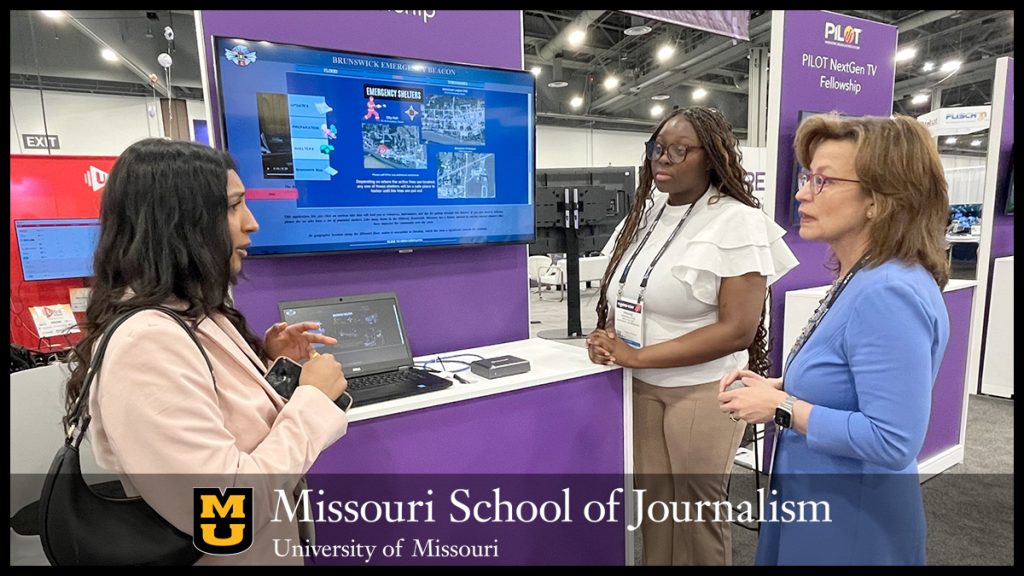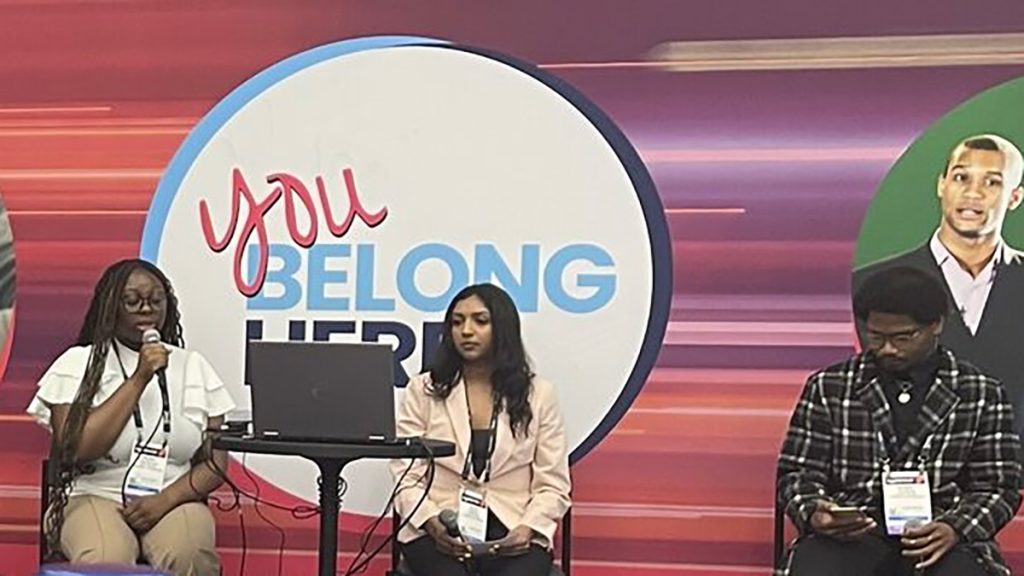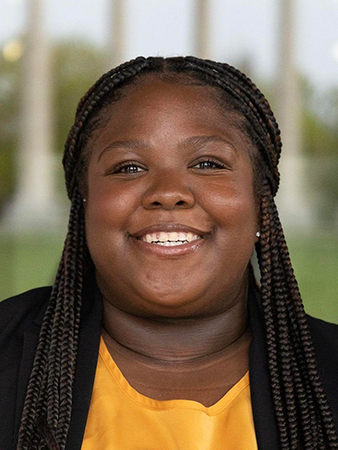NextGen TV innovation brings emergency alerts to underserved community

Kavya Ramesh [L] and Praise Aruwajoye [C] speak with FCC Commissioner Anna Gomez [R] during the NAB PILOT demonstration of ATSC 3.0 technology at the NAB Show in Las Vegas in April.
University of Missouri students received a front-row seat to the future of broadcasting this year through the PILOT NextGen TV Fellowship, part of the National Association of Broadcasters’ PILOT program.
As part of their yearlong fellowship led by Professor Jim Flink, journalism students Mikayla Higgins and Kavya Ramesh, alongside Mizzou engineering students Kenney Jackson and Praise Aruwajoye, developed a broadcast-based emergency communication interface designed for rural, under-connected communities that have limited cell service and internet connectivity.
The project was supported through the NextGen TV Fellowship, launched in 2021 with support from Amazon Web Services to give students the chance to design and build functional, broadcast-ready applications for ATSC 3.0.
The newest version of the Advanced Television Systems Committee standards, ATSC 3.0 is expected to transform how audiences interact with television by layering interactive content over live broadcasts and merging the internet with traditional over-the-air signals.
“ATSC 3.0 is a broadcast standard with the ability to tier content out of your television set and merge the internet with your television set,” said Flink. “For example, you’re watching a chef on the ‘Today’ show. With NextGen TV, you can click a button on your remote and see the recipe or the books they’ve published. It’s stackable content laid over the television broadcast.”
The team traveled to Brunswick, Missouri, where internet and cell service are “spotty at best,” Flink said. “But over-the-air television is reliable. That’s where this tech really shines,” he added.
However, Brunswick is still a 1.0 market — or a “one-dot world,” as Flink puts it. This means the team had to reverse-engineer their solution to work within existing infrastructure.
“What we’re doing is we’re basically reverse-engineering 5G’s content over your television set,” he said.
The team interviewed the town’s mayor and emergency management director to better understand the community’s needs. In addition to limited broadband access, Brunswick is divided by a river and has experienced significant emergencies in recent years, including two 100-year floods and a train derailment.

Using ATSC 1.0 technology and in partnership with SpectraRep, the team built an emergency messaging interface that delivered trusted, actionable instructions, like shelter locations and evacuation routes directly to residents’ television sets.
“The rise of these events is alarming, and a tool like this is necessary today, especially in areas with low bandwidths,” Higgins said. “Tools like these are needed so residents can access resources that are not only helpful but accessible as well.”
The Mizzou team capped off their year by presenting their work at the NAB Show in Las Vegas in early April, where they showcased their project directly to FCC Commissioner Anna Gomez.
“I’ve always been interested in the behind-the-scenes aspects of broadcast television, and this conference offered a chance to learn from innovators, connect with professionals and explore where the industry is headed.”
Kavya Ramesh
Ramesh and the team toured the convention floor while Flink remained at the booth, demonstrating their work to industry vendors, executives and developers among more than 80,000 attendees.
“That kind of exposure is huge,” Flink said. “Students roll up their sleeves, solve a problem, build it, show it and display it. You don’t get opportunities like that very often.”
Ramesh, a junior at Mizzou double majoring in journalism and political science, is currently studying and interning abroad in London. But the opportunity to travel to Las Vegas and present at the NAB Show was too valuable to pass up. She returned more inspired by the intersection of storytelling and technology.
“I’ve always been interested in the behind-the-scenes aspects of broadcast television, and this conference offered a chance to learn from innovators, connect with professionals and explore where the industry is headed,” Ramesh said. “I loved touring the AWS booth. They had cutting-edge technologies — everything from cloud-based production systems to AI-powered content creation. It sparked a lot of ideas for how these tools could be integrated into the newsroom.”
“Collaborating with the team was an enjoyable experience that required a lot of problem-solving. The project pushed me to think more holistically and use my communication skills to articulate my ideas.”
Mikayla Higgins
Other participating universities focused on different applications, like immersive sports broadcasting or GPS-alternatives powered by broadcast technology. Mizzou’s team focused on utilizing technology for public service and community needs.
“We’re trying to serve communities with critical infrastructure,” Flink said. “We’re asking what the community needs, and how this technology can enhance it.”
As the broadcast industry continues to evolve, projects like the Brunswick prototype show how journalism and technology can work together to serve the public good, especially in underserved areas.
“Focusing on a service and public safety project meant a lot to me,” Higgins said. “Collaborating with the team was an enjoyable experience that required a lot of problem-solving. The project pushed me to think more holistically and use my communication skills to articulate my ideas.”
Updated: April 29, 2025

